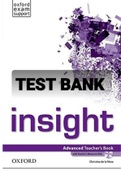1 Christina de la Mare
Advanced Teacher’s Book
4010856 insight Adv TB_PRESS.indb 1 26/08/2015 13:36 Design to supply Head Unit and banner
Introducing insight 4
C
omponents of the course 6
Student
’s Book at a glance 8
W
orkbook at a glance 11
Classr
oom Presentation Tool 13
Teaching notes
Unit 1 14
Unit 2 26
Unit 3 38
Unit 4 49
Unit 5 61
Unit 6 72
Unit 7 84
Unit 8 96
Unit 9 108
Unit 10 119
W
orkbook answer key 130
T
eacher’s Resource Disk 156
C
ommunication worksheets 156
insight DVD extra worksheets 158
Contents
00b Insight Adv TB_intro.indd 3 23/04/2019 14:29 4Aims of the course To challenge students to think critically about the world around them
insight has been developed not only to teach students English, but also to increase their awareness of the world around them. Amongst other topics, insight addresses social issues, culture, literature, history, social media, science and technology. Students are encouraged to think critically about the issues raised, to evaluate their current point of view, and to share their opinions with others even once they have left the classroom. Texts and recordings include an interesting fact or unexpected opinion which students may want to tell their friends and families about. This will help make the lesson more memorable and help students recall the language and ideas they have learned. Video documentary clips also cover cultural and historical themes broadening students’ understanding of the customs, traditions and history of English-speaking countries. Literature insight introduces students to classic works of English literature and offers an alternative way of exploring the culture of English-speaking countries. To inspire discussion in the classroom
The information-rich and thought-provoking texts and recordings will inspire discussion amongst students. Structured activities encourage students to question their existing opinions and the opinions of others. Activities are designed to stimulate critical thinking, to encourage participation and the exchange of opinions.
The speaking sections also teach the skills needed to be an active participant in discussions, such as interrupting, asking for clarification, disagreeing, and encouraging others to speak. To give a deeper understanding of vocabulary and build the confidence to use it
insight gives students a deeper understanding of language and goes beyond purely teaching meaning. insight explores such areas as collocation, word-building and connotation to provide a fuller understanding of how vocabulary is used. This comprehensive approach allows students to use new language with greater confidence.
Vocabulary is taught in the context of reading or listening texts. All reading and listening texts are accompanied by vocabulary exercises that focus on the meaning of new vocabulary in context. Additionally, the understanding of new vocabulary is reinforced through exercises which practise their use in a new context.
All vocabulary is taught in sets organized by topic, word type or theme. Research has shown that teaching vocabulary in this way makes it easier for students to recall and use.
Vocabulary insight pages not only explore language in more depth, but also build students’ study skills, including keeping vocabulary records, ways of recording new vocabulary, using a dictionary and a thesaurus. These skills will help students decode, retain and use new vocabulary correctly in the future. Introducing insight
A note from the author
I’m reading a book called The Element by Ken Robinson. On a table nearby, a few teenagers are chatting with their friends after a long day at school. ‘Our task is to educate (our students’) whole being so they can face the future,’ I read. ‘We may not see the future, but they will and our job is to help them make something of it.’ I look at the kids and think: ‘That’s quite a big task!’
It’s a challenge we all face, whether we’re teachers, parents, educational writers or youth workers. Our short-term objectives may be different: we may help teenagers or young adults pass school-leaving exams, understand maths formulae, or take part in community projects. But ultimately our long-term objectives are the same: to help young people develop a passion for and curiosity about life, to give them confidence in their own ideas, to help them become open-minded, global citizens.
When I started writing insight I immediately understood that the course was trying to satisfy these two objectives: a rigorous syllabus would help students develop their language skills, but it also had its eye on long-term objectives, too.
Today’s students are very sophisticated. They have an amazing ability to multitask, and they often have a broad knowledge of other cultures and countries. They also have a point of view, and in insight we value that and seek it out – we also challenge it. We constantly ask students to question, evaluate and make cross-cultural comparisons: What do you think? Do you agree? What would you do? Speaking helps develop their confidence as language learners, but it also develops confidence in their own opinions and beliefs.
In insight we’ve added a special ingredient, too: in many texts and topics there is a fact or point of view students may not have come across before, something surprising or thought-provoking, something they may want to tell their friends in a café after school. The aim of this extra ingredient is to inspire curiosity, and a passion to discover and learn. It might help them think about an issue in a different way, and make a lesson more memorable. That’s what insight is all about. It strives to create the right conditions for students to grow, learn and develop their ideas and experience. To become lifelong learners. ‘You cannot predict the outcome of human development,’ adds Ken Robinson, wisely. ‘All you can do is like a farmer create the conditions under which it will begin to flourish.’
Jayne Wildman
4010856 insight Adv TB_PRESS.indb 4 26/08/2015 13:36




